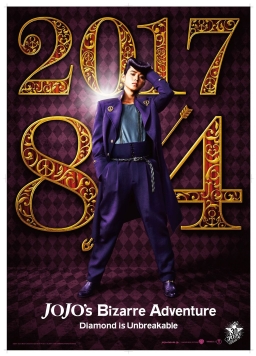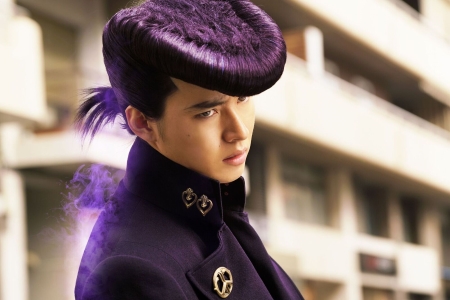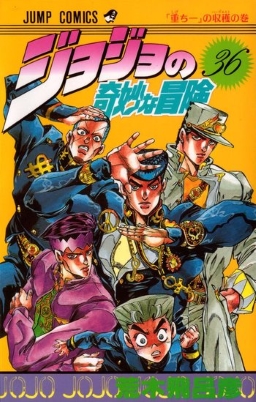Fantasia 2017, Day 1: The Bizarre Adventure Begins (JoJo’s Bizarre Adventure: Diamond Is Unbreakable)
 The body has a memory, memory activated by the time of year and the weather and the repetition of physical activity. Every year now as summer passes its midpoint, walking through Montreal evokes for me a sense of wonder and anticipation: a physical remembrance of the Fantasia International Film Festival. I’ve covered Montreal’s genre film festival for Black Gate the last three years, walking downtown during the days of the festival and then walking back at night marveling at the things I’ve seen. Last Thursday for a fourth year I set out for the Fantasia theatres at Concordia University’s downtown campus; and so here is the first installment of my Fantasia diary for 2017.
The body has a memory, memory activated by the time of year and the weather and the repetition of physical activity. Every year now as summer passes its midpoint, walking through Montreal evokes for me a sense of wonder and anticipation: a physical remembrance of the Fantasia International Film Festival. I’ve covered Montreal’s genre film festival for Black Gate the last three years, walking downtown during the days of the festival and then walking back at night marveling at the things I’ve seen. Last Thursday for a fourth year I set out for the Fantasia theatres at Concordia University’s downtown campus; and so here is the first installment of my Fantasia diary for 2017.
As always, I’m looking forward over the coming weeks to things I’ve heard of and things I’ve never heard of. I’m trying to figure out what movies I’ll have to pass on seeing in order to watch other movies scheduled against them, and then what movies I’ll be able to see on a computer monitor in the Fantasia screening room. This year the recipients of the festival’s Lifetime Achievement Awards are a little outside my immediate areas of interest — B-movie auteur Larry Cohen, luchador and movie star Mil Máscaras, and Cüneyt Arkin, star of over 300 Turkish films including The Man Who Saved the World (Dünyayi Kurtaran Adam, also known as “Turkish Star Wars”). But who knows if I’ll find myself sitting in on a screening of one or more of their varied works?
This year I began my Fantasia experience on the festival’s first night, Thursday July 13, with a viewing of Jojo’s Bizarre Adventure: Diamond is Unbreakable. I arrived early, reaching the Hall Theatre at 8:30 PM for a 9:45 screening, and found a line-up of ticketholders already stretching a good 200 feet. The movie’s directed by Takashi Miike, a winner of last year’s Lifetime Achievement Award, with a script by Itaru Era based on the long-running manga by Hirohiko Araki. I happened to watch this showing in the company of the redoubtable Dave Harris of Pieuvre.ca; neither of us had any experience of the manga, but after the movie we were able to speak briefly with some friends of Dave’s who were fans of the comics. “11 out of 10,” said one, while another said that the movie was so faithful it replicated specific panels on the screen. So: if you’re a fan of the source material, you will like this movie. What about those who aren’t?
 I felt it was entertaining if unexceptional, and overall a mixed bag. We follow Koichi (Ryûnosuke Kamiki, of Too Young to Die, Poison Berry In My Brain, and the Rourouni Kenshin movies), a transfer student getting used to life in the near-idyllic town of Morioh, as he encounters the super-powered JoJo (Kento Yamazaki). In quick succession JoJo encouters a villain (Takayuki Yamada, of Miike’s Terraformars) who was given strange powers by a mysterious archer (Masaki Okada, The Top Secret: Murder In Mind and Strayer’s Chronicle); learns about his past and powers; and is brought into a supernatural world he cannot escape — with Koichi tagging along.
I felt it was entertaining if unexceptional, and overall a mixed bag. We follow Koichi (Ryûnosuke Kamiki, of Too Young to Die, Poison Berry In My Brain, and the Rourouni Kenshin movies), a transfer student getting used to life in the near-idyllic town of Morioh, as he encounters the super-powered JoJo (Kento Yamazaki). In quick succession JoJo encouters a villain (Takayuki Yamada, of Miike’s Terraformars) who was given strange powers by a mysterious archer (Masaki Okada, The Top Secret: Murder In Mind and Strayer’s Chronicle); learns about his past and powers; and is brought into a supernatural world he cannot escape — with Koichi tagging along.
The plot’s effective but a little ragged — thus JoJo encounters a figure out of his family past soon after his first conflict with a supervillain, and there doesn’t seem to be a connection between these two things. Other plot points are left undeveloped — the strange behaviour of Koichi’s tutor Yukaku (Nana Komatsu), for example — and the last moments of the film introduce a climactic mystery that presumably will be investigated in future films. The friendship between Koichi and JoJo was left rudimentary, to my mind, as though a scene establishing or advancing their relationship had been dropped.
But these are relatively minor complaints. The shape of the flim mostly works for a superhero-adjacent action movie. JoJo’s powers are explained quickly but effectively, characters are set up well, and in general action beats advance the plot and reveal character. The major exception is the very end of the movie, when after all the fighting’s done a final revelation takes place and eats up minutes of screen time that feel anti-climactic after the big conflict that immediately preceded them. On the other hand, that scene ends with the aforementioned mystery cliffhanger, so I can imagine that it’ll feel more logical when the whole of the film saga’s complete. The movie is, overall, a satisfying story for the kind of story it’s trying to be.
 It’s difficult, in fact, not to compare it to an American comic-book super-hero movie. Not just in the general approach a story of super-powered heroes and villains, but in the way it presumes a fan audience and further chapters to come. If you’re ignorant of the source material (as I was), characters are introduced with odd dramatic flourishes, things are set up without paying off, and an odd portentousness adheres in odd moments to unexpected things. All of these things fit the story that fans know, and could well make sense in the broader context of a multi-film epic. But for those who don’t already know the story, the film occasionally feels weighted in strange ways. Add it all up at the end, and things make sense. It’s just in the moment in the theatre, an unclued-in watcher may be left wrong-footed.
It’s difficult, in fact, not to compare it to an American comic-book super-hero movie. Not just in the general approach a story of super-powered heroes and villains, but in the way it presumes a fan audience and further chapters to come. If you’re ignorant of the source material (as I was), characters are introduced with odd dramatic flourishes, things are set up without paying off, and an odd portentousness adheres in odd moments to unexpected things. All of these things fit the story that fans know, and could well make sense in the broader context of a multi-film epic. But for those who don’t already know the story, the film occasionally feels weighted in strange ways. Add it all up at the end, and things make sense. It’s just in the moment in the theatre, an unclued-in watcher may be left wrong-footed.
What may be most surprising, though, is the way the film isn’t much of a distinctively Miike movie. It’s slow, especially in its first half, not in the pace of its plot development but in the rhythm of its edits. It feels on the whole restrained — there are few striking visual moments, and no sense of transgression. The story’s told straight, and compared even to something like last year’s Miike manga adaptation Terraformars it’s low-key. There is humour, and it works, but it’s in no sense boundary-pushing. There’s a sense here that Miike has entirely subordinated himself to the requirements of the job, which can be seen as either professionalism or the blunting of an individual voice.
Notwithstanding this, the movie’s pleasant to look at, colourful, with an always-solid compositional sense. Settings are prettily cluttered, with detail creating an almost theme-park feel; there’s an artificiality to the town of Morioh, and especially to the crumbling house that’s the setting of the final confrontation. This works nicely with the larger-than-life story, and with the larger-than-life character designs — the characters with special powers all have strange hairstyles, which itself makes for a running joke about JoJo’s touchiness about his hair. Miike does occasionally create moments where the character of a place inflects a scene with particular drama; I’m thinking especially of a set-piece in which an empty flooded kitchen creates tension and even moments of horror.
 Worth noting, too, is that the CGI works to sustain the story’s feel. Miike stages the fights well, and varies the tones of the confrontations across the movie. The first visual representation of the characters’ powers are quick flashes; you wonder what you saw, even what’s happening. Then more and more we come to grasp the nature of the things we’re seeing. Moments that could have been horrific are given visual designs that bring out a softer, comedic edge. Conversely, climactic moments are both unreal and weighty, drawing blood and creating a convincing sense of desperation.
Worth noting, too, is that the CGI works to sustain the story’s feel. Miike stages the fights well, and varies the tones of the confrontations across the movie. The first visual representation of the characters’ powers are quick flashes; you wonder what you saw, even what’s happening. Then more and more we come to grasp the nature of the things we’re seeing. Moments that could have been horrific are given visual designs that bring out a softer, comedic edge. Conversely, climactic moments are both unreal and weighty, drawing blood and creating a convincing sense of desperation.
For a non-fan, then, this is a pleasant though not exceptional action-fantasy. Is there, in the end, a point to the movie? Bits of dialogue in the film try to suggest a theme about destiny, while the plot sets up a story partly about death but mostly about family. This is a movie in which the mystery of the lead character’s lineage becomes a subplot, and in which the villains are linked and motivated by blood ties. As with many superheroes, the lead character must negotiate the questions surrounding his mysterious birth-parentage as well as his love for the people who’ve actually raised him. And if I’ve mentioned superheroes a fair amount in this review, it’s because this is also a film about a powerful young man weighing the moral necessity of putting himself in danger to protect others from the dangers of a world beyond the everyday. It’s the story of a hero learning that with his great powers comes a great responsibility, and who can argue with that?
JoJo’s Bizarre Adventure has already been adapted into anime and into live-action TV. Diamond Is Unbreakable is the fourth storyline in the manga (Wikipedia tells me it takes up volumes 29 through 46 of the 119-volumes-and-counting saga), and this film is the first part of that story. Sequels are anticipated but not confirmed. Viz Media has released some of JoJo’s Bizarre Adventure in English translation, and has announced plans to publish an English version of the Diamond Is Unbreakable storyline, but has not yet given a publication date.
In all, the movie was a good start to this year’s Fantasia. An ecstatic audience that cheered every beat wildly, a solid action story, and something that was a bit new to me. It boded well for the next three weeks of films.
I take a look at the American action film Atomic Blonde here. Here I take a look at the American thriller Tilt, the American art film A Ghost Story, and the Japanese crime-horror manga adaptation Museum. Here I look at two sets of short films, the first being SpectrumFest: Films From the Autism Spectrum, which gathers together shorts by young filmmakers on the autism spectrum; the second being the International Science-Fiction Short Film Showcase 2017. I discuss Mohawk, an action-suspense movie set in the war of 1812, here. Here I look at the Chinese historical art-action movie The Final Master and the Japanese horror/urban-fantasy manga adaptation Tokyo Ghoul. Reviews of the American independent art-horror-teen movie The Honor Farm, the Hong Kong action movie Shock Wave, and the Chinese art-house movie Free and Easy are here. Here I look at the German art-thriller Animals, the Chinese special-effects blockbuster Wu Kong, and the Korean horror movie House of the Disappeared.
I discuss the Italian suspense-thriller The Laplace’s Demon here. Here I look at the near-future dieselpunk anime Napping Princess and the VR documentary Welcome to Wacken, while here I write about the horror-oriented short film showcase Born of Woman 2017 and the Korean time-loop thriller A Day. Here I consider the 1950s Japanese science-fiction/horror movie The H-Man (along with the biography of its director, Godzilla creator Ishiro Honda), the classic Shaw Brothers wuxia movie Bastard Swordsman, and the comedic science-fictional manga adaptation Gintama. Between the movies I saw a presentation of Paperbacks From Hell, a survey of the horror paperback boom of the 1970s and 80s, and here I have an interview with author Grady Hendrix. Here I look at the visionary stop-motion science-fiction/horror film Junk Head. I consider the latest entry in the Japanese live-action Death Note franchise, Death Note: Light Up the New World, here. Here I look at 78/52, a documentary about the shower scene in Hitchcock’s Psycho. And here I look the wondrous folkloric Estonian film November, and the documentary Tokyo Idols, about pop music, obsession, and heroes.
I look here at Town In A Lake, an artistically ambitious film from the Philippines with crime and fantastic aspects, and Let There Be Light, a documentary about the attempt to develop fusion power. I consider the German historical crime film Fritz Lang and George Romero’s horror-satire The Crazies here. Here I look at the Russian science-fiction epic Attraction, and a set of three Asian animated short films, “Valley of White Birds,” “Scarecrow Island,” and “Cocolors.” I discuss the documentary Geek Girls, about women and fandom, here. Here I look at the satirical Japanese historical action-comedy Mumon, the American action film Bushwick, and the German science-fiction movie S.U.M.1. Here are reviews of the Japanese animated college film Night is Short, Walk On Girl; the Italian documentary about modern exorcists Deliver Us; and the Japanese historical-action manga adaptation Blade of the Immortal. The Japanese animated kids’ film Lu Over the Wall, the Polish crime film Spoor, and the Turkish post-apocalypse movie Nomad are discussed here. Here I review the art-horror film Indiana, the psychological suspense thriller Fashionista, and Dario Argento’s psychedelic horror fairy-tale masterpiece Suspiria. I look at the Japanese social satire Japanese Girls Never Die, the Thai historical martial-arts movie Broken Sword Hero, and the Chinese historical blockbuster God of War here. Finally, I have some concluding thoughts here.)
Matthew David Surridge is the author of “The Word of Azrael,” from Black Gate 14. You can buy his first collection of essays, looking at some fantasy novels of the twenty-first century, here. His second collection, looking at some fantasy from the twentieth century, is here. You can find him on Facebook, or follow his Twitter account, Fell_Gard.
I always enjoy your Fantasia coverage. Makes me wish I could spend a summer in Montreal.
Thank you, Sarah! I do recommend the Montreal summer experience.
I am glad you liked “Jojo’s Bizarre Adventure” more than I did; but then, most people did. There was something truly off about it for me — something that I never quite comprehended, I guess. (And I’m used to not understanding things; part of my job as a 366 reviewer.)
The action never felt right (what little there was), and the only character worth mentioning was tertiary: Jojo’s father. Perhaps a movie focusing on his daily travails as a cop could have worked. As it stands, the adventures of Jojo and company just fell apart — even facing a mind as open as mine is.
(Able review, though; indeed, I was that “unclued-in watcher [who was] left wrong-footed.”)
Looking forward to your other reviews — forthcoming, I presume?
Hi, Giles! Yes, more reviews forthcoming; the next should be up in a matter of hours.
Thanks for the comments! I do see where you’re coming from with what you’re saying, but for whatever reason, the action worked well enough for me and the lack of character depth felt fair enough for the kind of movie it was. Maybe it’s just that I’ve seen enough American superhero movies *as an American superhero fan* that I could relate to JoJo’s Bizarre Adventure in a specific way: even though I’m not a fan of the mange, I’m able (unconsciously) to sort of back-formulate the fan experience from a movie that’s not too far distant from the superhero films I know. That is, I can imagine how lost somebody would be coming to a Marvel movie with no understanding of the source material, so without noticing it I tend to adjust for the same kind of confusion. I don’t know how much that makes sense, but it’s a theory …